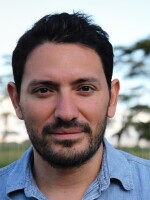George Rodrigue, the artist who transformed the image of Louisiana's loup-garou into a pop art icon, died on Saturday after a battle with cancer.
Rodrigue took the legend of the Cajun werewolf and transformed it into instantly recognizable portraits of a quizzical blue dog framed by different landscapes.
In a statement on his website, Rodrigue's family said the artist's intent was always "to paint Louisiana as he knew it by visually interpreting the landscape and the rich history of the Cajun people."
Rodrigue died in Houston. He was 69 years old.
In a statement, Lousiana Gov. Bobby Jindal said Rodrigue was one of Louisiana's "favorite sons."
"His work as an artist is iconic and uniquely Louisiana," Jindal said. "George's Blue Dog not only became symbolic of his work, but it became a symbol for Louisiana. This earned him the ability to paint the likes of world leaders including Ronald Reagan, George H.W. Bush, and Bill Clinton."
Before his Blue Dog period, Rodrigue was a renowned folk artist. As his wife explained in a 2010 blog post, his reputation as a fine artist peaked when he released The Cajuns of George Rodrigue in 1976. Rodrigue had been painting Cajun landscapes marked by moss-covered oak trees.
Rodrigue stumbled upon the Blue Dog in a way. He was commissioned for a painting inspired by Cajun ghost stories. As he told PBS, he remembered that as a child his mother would always warn him that if he wasn't good, the loup-garou would come and get him.
He explored that story and ended up representing the werewolf with the image of an old studio dog he had. That turned into the Blue Dog and he said at the beginning of that period, he heard many nay-sayers, telling him that such popular art would ruin his reputation.
But Rodrigue said he really got to like the fight for a popular audience, where an artist has to paint something that "really attracts the attention."
As The New Orleans Times-Picayune reports, after he exhibited the Blue Dog in Los Angeles in 1988, "it became a near-constant motif in the artist's work."
Copyright 2021 NPR. To see more, visit https://www.npr.org.






